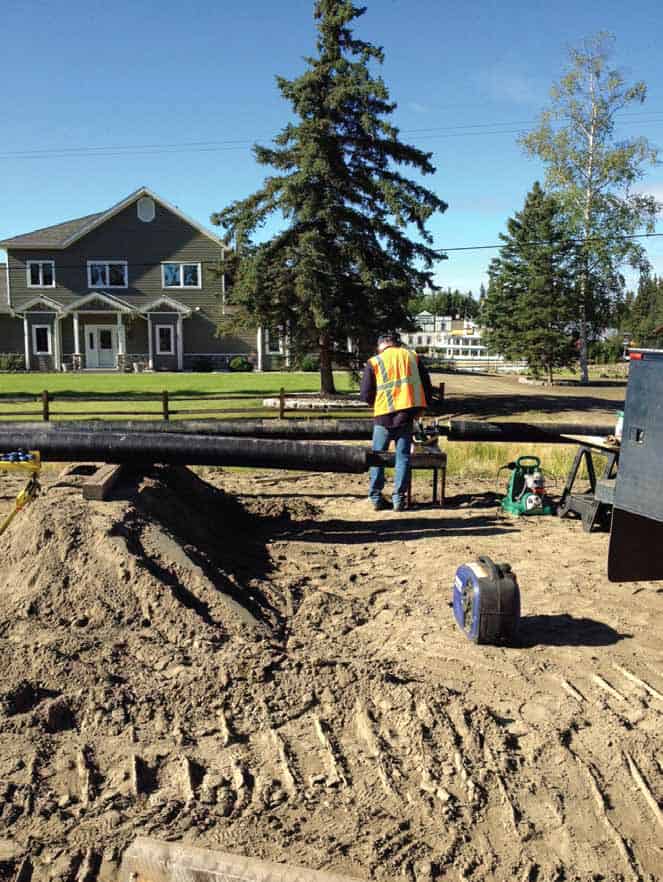Fairbanks, Alaska Installs HDPE for Water Lines

In Alaska water utilities have extreme conditions to deal with when designing and installing water service lines to their customers. Many customers in this region run off well systems that are becoming increasingly dry. The challenges they face are extreme annual ground movement from deep frost lines, long periods of freezing temperatures, aggressive soil conditions, short installation periods, rugged hill side landscapes, high logistics costs, and growing infrastructure demands both old and new. A pilot PE-4710 HDPE piping system was installed to address all these needs in Fairbanks in the Chena Acres district.
Chena Acres 7200 foot 4” DR 11 PE-4710 water main pilot project was conceived to address the cost and benefit questions for a practical and safe water supply in this area. In 2007 College Utilities LLC installed the “Sherwood Phase I” project using 14,000 feet of ductile iron piping which included fire hydrants every 300ft that cost $2.7million. This rural hill side project to supply water created high owner assessments from $15,000 to $22,000 per lot. Only 9 out of 52 residences connected to the service since the installation. This created future concerns for the Sherwood Phase II project which required a 31,330 foot installation slated for 2013 to service 162 lots. The Phase II portion of the project was reaching astronomical costs utilizing traditional steels and was difficult to gain any necessary funding approvals.
So, in 2012, Tarik Spear Superintendent of College Utilities Corp. presented a proposal to run a pilot project of 7200 feet in Chena Acres, Fairbanks using PE-4710 HDPE piping to determine feasibility, costs, and ease of installation. The pilot project was approved and installed in the summer/fall of 2012.
Even with the higher initial learning curves using the HDPE material, the pilot was a complete success and significantly reduced project costs. From the pilot project data gathered, College Utilities Corp., cost estimates for Phase II servicing 169 lots versus 52 in Phase I was calculated at $1.47 million using PE-4710 HDPE pipe. This was a 54.4% reduction in cost from initial project costs for Phase II. This was considered substantial and the pilot project also answered many outstanding questions the Approval Boards had regarding HDPE piping systems installations.
The project utilized open trench 5-6 feet deep, but the trenches were narrower allowing smaller equipment to be used and reducing excavation costs. This was also beneficial for the placement of the pipeline to reduce destruction or damage to surrounding forest and roadways.
Labor costs reductions utilizing 50 foot joints as opposed to 20 foot reduced the number of joints by 228 equaling a labor and installation savings of $33,000.00 for this relatively short pipeline. Utilizing fused joints eliminated all mechanical and bell and spigot joints creating a monolithic line which is expected to withstand ground movements in area keeping water system leak free. In addition, there was added safety benefits built into the project because no personal needed to go down into a trench because the piping system was built completely on top and outside of the trench.
Further benefits included resistance to corrosion. The soils in the area being organic corrosive soil material called “Blue Loom”, PE-4710 HDPE materials eliminate these corrosion factors, which adds to expected life cycle of the pipeline. The homeowner’s assessment costs were reduced by half from the Phase I project making hook-ups to the main service more affordable. Another benefit was the cost savings on logistics. Because all pipe in Alaska must be insulated prior to installation the steel versus HDPE weight difference allowed for more pipe per truck load reducing logistic costs significantly.
Overall the pilot project was a complete success and Tarik looks forward to completing the much-needed Phase II of the Sherwood project in 2013, as well as, using HDPE for other needed projects in the area. “This pilot project allowed us to better understand HDPE installations and we will only get better and more efficient installing them in the future.”
Not only did this community benefit from a robust, leak free, and environmentally friendly water system with long expected service life cycles, it also saved them money.